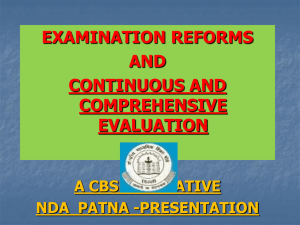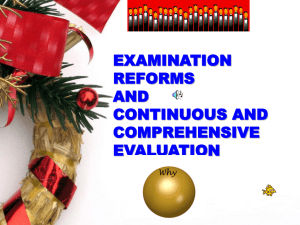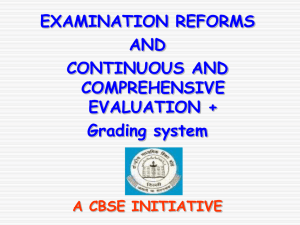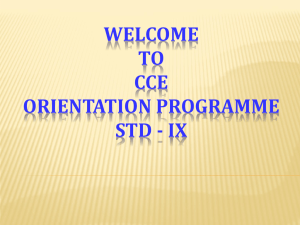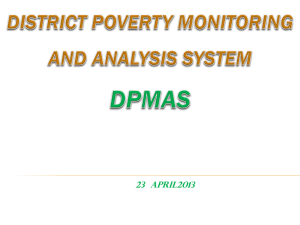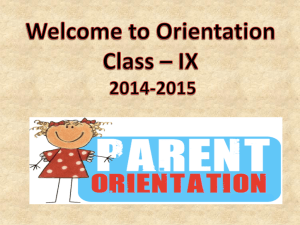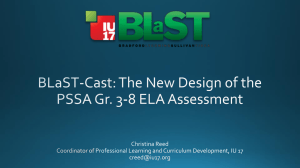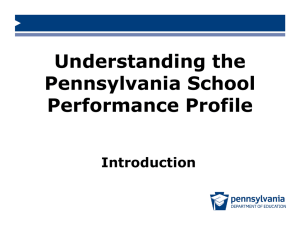CCE - AECS, Narora
advertisement
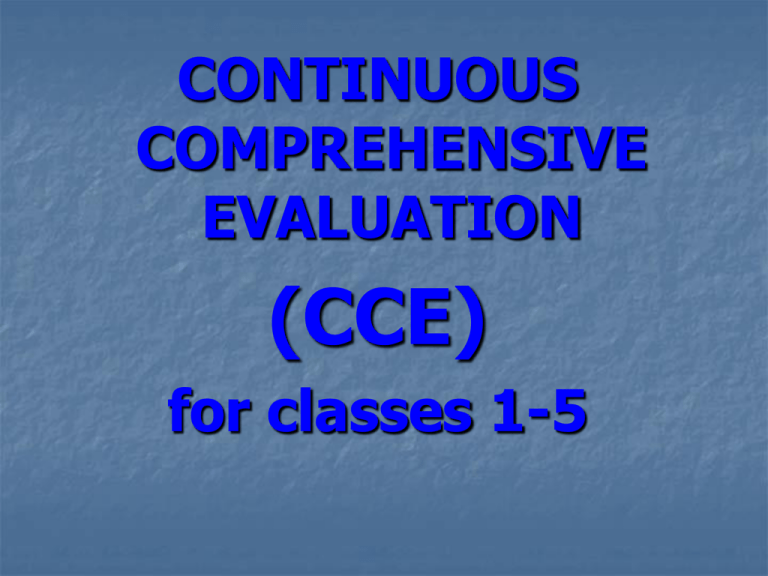
CONTINUOUS COMPREHENSIVE EVALUATION (CCE) for classes 1-5 WHAT IS CONTINUOUS COMPREHENSIVE EVALUATION ? Continuous and Comprehensive evaluation refers to a system of school based assessment that covers all aspects of student’s development. It emphasizes two fold objectives. Continuity in evaluation and assessment of broad based learning. Behavioral out come. WHY CONTINUOUS COMPREHENSIVE EVALUATION External Examinations ‘are largely inappropriate for the knowledge society of the 21st century and its need for innovative problem solvers‘ Evaluation of Scholastic learning only on marks. Ability of child not evaluated. Limited Techniques of Evaluation do not identify learner’s level of attainment. Resulting in Pass/Fail. Causing frustration and humiliation . HOLISTIC COMPREHENSIVE SCHOOL BASED ASSESSMENT VALUES & ATTITUDES SCIENCE LANGUAGES ENGLISH SUPW MATHS SCHOOL SPORTS LIFE SKILLS MUSIC COMPUTERS ART DANCE SOCIAL SCIENCE FEATURES OF CCE Continuous Continual—from the beginning and during the instructional process Periodicity—frequency /term Comprehensive ASSESSMENT/EVALUATION CONSISTS OF FORMATIVE SUMMATIVE ASSESSMENT AREAS SCHOLASTIC CO-SCHOLASTIC Scholastic Academic Computer Education/Craft Environmental Education Art Education Co- Scholastic Life Skills Attitudes and Values Health and Physical Education SCHOLASTIC ENGLISH MATHS HINDI EVS MUSIC Environmental education ART COMPUTER EDUCATION/CRAFT CO-SCHOLASTIC LIFE SKILLS Health and Physical Education CREATIVE & LITERARY CLUBS (ECO & HEALTH ) SCIENTIFIC AESTHETIC ATTITUDE & VALUES PERFORMING ARTS • Scholastic •Subject specific areas. • Co-Scholastic •Life skills, attitudes & values and other Co-curricular activities. Scholastic Evaluation Formative Assessment : Assessment which is carried throughout the year by the teacher formally and informally It is diagnostic and remedial Summative Assessment: End of term or end of the year exams Feedback on learning (assessment of learning) to teacher and parents FORMATIVE ASSESSMENT (FA) Will comprise of : • Class work . Memory Test • Homework . Story Telling • Oral questions . Elocution • Quizzes . Dictation • Projects • Assignments/Tests SUMMATIVE ASSESSMENT(SA) Will be Term End Examination: •Question papers to be prepared by schools. •Exam to be conducted by schools •Evaluation of Answer scripts will be done within the school. Terms in an Academic year Academic year will have 2 terms - FIRST TERM : April to September SECOND TERM: October to March ASSESSMENT FOR AN ACADEMIC YEAR Term I – FA1 and FA2 SA1 Term II - FA3 and FA4 SA2 FINAL AssessmentFA1+FA2+FA3+FA4 10+ 10+ 10+ 10 = 40% SA1+ SA2 20 + 40 = 60% TOTAL = 100% GRADING SYSTEM for SCHOLASTIC -A MARKS /50/100 GRADES 45—50 90-100 38—44 75-89 28—37 56-74 18—27 35-55 0—17 0-34 A* A B C D SCHOLASTIC -B Craft ,Art, Music Computer Education Environmental Education GRADES A* A , B, C , D GRADING SYSTEM ADVANTAGES Minimize misclassification of students on the basis of marks. Eliminate unhealthy cut throat competition among high achievers. Reduce societal pressure and provide the learner with more flexibility. Lead to a better learning environment. PLACE OF EVALUATION IN THE CURRICULUM CURRICULUM TOTAL TEACHING-LEARNING PROGRAMME SYLLABUS MATERIALS ASSESSMENT TEACHING METHOD LEARNING TRANSACTION PLACE OF ASSESSMENT IN THE CURRICULUM WHAT SHOULD BE ASSESSED? RESPONSE SKILL VALUES PHYSICAL HEALTH SCHOOL CLUBS MOTIVATION APPLICATION FIRST AID RETENTION YOGA ATTITUDES INTELLECTUAL SOCIO-EMOTIONAL BEHAVIOUR SUBJECT AREAS AESTHETICS SOCIAL – ENVIRONMENT ISSUES LIFE SKILLS CREATIVITY INTERESTS WHAT IS ASSESSMENT? FORMATIVE SUMMATIVE NO OPEN COMPARISION TEACHER PERIODICITY CONTINUOUS DIAGNOSTIC ADDRESSES LEARNING STYLES REMEDIAL TEACHING REVIEW STUDENT SELF ESTEEM SELF EVALUATION UNDERSTANDING OF EVALUATION IMPROVEMENT PEER SUPPORT WHEN ASSESSMENT SUMMATIVE? SUMS UP – GIVEN POINT OF TIME GRADE/ SCALE COGNITIVE & PSYCHOMOTOR AREA AGE APPROPRIATE PROFILE REPORT MARKS UNHEALTHY COMPETITION UNFAIR UNSCIENTIFIC OVEREMPHASIS ON SCHOLASTIC DO’S INFORMATION POSITIVE MULTIPLE AFFIRMATIVE COLLECTION FEEDBACK INTELLIGENCE ACTION DONT’S LABELLING COMPARING NEGATIVITY TEACHERS UNDERSTANDING ASSESSMENT KNOWLEDGE SKILLS POSITIVE ATTITUDE VALUE REASON FOR ASSESSMENT: VISION OF GOOD QUALITY LEARNING EXPECTED LEARNING PROGRESS ACHIEVEMENT IN SUBJECT OWN PACE CONSTRUCT KNOWLEDGE SPIRAL CONSTRUCTIVIST LEARNING ACTIVITY-BASED CONTINUOUS MISTAKES EXPERIENTIAL LEARNING ASSESSMENT CONSISTS OF FORMATIVE SUMMATIVE ASSESSMENT AREAS SCHOLASTIC CO-SCHOLASTIC Narrative records Photographs/ Videos Portfolio Questions Essays Assessment Conversation Skills Observation Self Assessment Assignments Tools & Projects Techniques Quizzes Checklist Oral Questions Research Work (group) Rating Scales Observation Peer Assessment Narrative Reports Paintings/ Artistic Endeavour Assessment - Design April – JulySept July Sept Oct – Dec DecMar Mar FA1 FA2 SA1 FA3 FA4 SA2 10% 10% 20% 10% 10% 40% Scholastic Formative Summative What is Formative Assessment What does it mean? How does it help the teacher and the student? Formative Assessment For the Teacher Diagnostic &Remedial Informs teacher where the need/problem lies. Focus on problem area. Helps teacher give specific feedback Provide relevant support Plan the next step Formative Assessment For the student Diagnostic &Remedial Helps student identify the problem areas Provides feedback and support. Helps to improve performance Provides opportunity to improve performance TEACHERS SHOULD KEEP IN MIND Use a variety of tools (oral, projects, presentations) . Understand different learning styles and abilities. Share the assessment criteria with the students. Allow peer and self assessment. Give an opportunity to the student to improve. A Successful Formative Assessment Scheme Plan all assessment Focus on formative assessment Share learning outcomes ,assessment and expectations with students Use clearly defined criteria Use examples and exemplars A Successful Formative Assessment Scheme Give specific feedback Incorporate student self assessment Students keep a record of their progress Teachers keep records of student progress Summative Assessment End of term or end of the year exams. Feedback on learning to teacher and parents SCHOLASTIC - A SUBJECTS • Hindi •English •EVS •Mathematics FORMATIVE Observation SKILLS Analysis Problem Solving Use of I.T. Correlation to real life Comprehension Expression Creativity Data Handling Oral Listening, Writing ADDITIONAL SUBJECTS • computer •Envi.Education •Art •Music •craft SUMMATIVE Questions Conversation Examination Project Short Answer Essay Very Short Answer Elocution Question Test TOOLS & TECHNIQUES Essay MCQ Data Interpretation Type of Questions for Formative & Summative assessment Alternative Response Type True/False Right/Wrong Yes/ No Single Matching Type Double Key/Check List Multiple Choice Type Question Form Matrix Incomplete Statement Fill in the blank ART EDUCATION INDICATORS Innovative and creative approach Exhibits aesthetic sensibilities Observation skills Interpretation and originality Correlation with real life Willingness to experiment with different art modes/ mediums Appreciate work of peers Awareness and appreciation of works of artists PHYSICAL AND HEALTH EDUCATION/GAMES INDICATORS Appreciation and understanding of good physical health Involvement in sports/physical education programs Team work Knowledge of different sports and rules of games Exhibits motivation and leadership Skills of coordination, agility and balance Awareness of rules of safety Evidence of being self disciplined OBSERVATION PORTFOLIO VIDEOS NARRATIVE RECORDS CHECKLIST INDICATORS : SOCIAL SKILL Student demonstrates the ability to: Identify, verbalize and respond effectively to other’s emotions in an empathetic manner. • Get along well with others . Most indicators in a skill •Take criticism positively. A* Many indicators in a skill A Some indicators in a skill B •Listen actively. •Communicate using appropriate words, intonation and body language. SOCIAL SKILLS – A CHECKLIST Does he/she show patience during a group task for slow learners to complete their task? Does he/she try to help a classmate who is feeling low or who's unable to cope up the given work? Does he/she appreciate the ideas and qualities of others? Does he/she feel comfortable sharing his ideas with others? Does the child always like to be appreciated? Does he/she come and ask how to correct the mistakes the teacher pointed out in his work? Does the student maintain a comfortable level of eye contact? Does the student interrupt to tell his own stories/give his opinion/offers unasked advice? Does he/she try to break rules setup for the task by using rude language? Does he/she try to exhibit negative behavior and upset others? Towards School Programmes Towards Teachers Value Systems PART 2B : ATTITUDES AND VALUES Towards Environment Towards school mates TOWARDS TEACHERS Most indicators in a skill A* INDICATORS : Many indicators in a skill A Some indicators in a skill B Shows respect and courtesy at all times Demonstrates attitudes that are positive and conducive to learning Takes criticism in the right spirit Respects and follows class, teacher and school rules TOWARDS SCHOOL MATES INDICATORS : Shares a healthy rapport with peers Most indicators in a skill A* Is able to interact and communicate effectively Many indicators in a skill A Some indicators in a skill B Receptive to ideas and opinions of others in a group Sensitive to differences among peers in – ability, religious beliefs, gender, culture etc. Is kind and helpful Able to inspire members of the class or peer group TOWARDS SCHOOL PROGRAMMES Most indicators in a skill INDICATORS : Is punctual and regular in attending school Many indicators in a skill Some indicators in a skill Participates and volunteers often for school programmes Delivers a job assigned effectively and responsibly Displays a healthy school spirit Displays leadership skills Inspires others to participate in school programmes A* A B INDICATORS : TOWARDS ENVIRONMENT Respects school property Is environmentally sensitive Participates in activities relating to care for the environment Takes the initiative and plans activities directed towards the betterment of the environment Most indicators in a skill A* Many indicators in a skill A Some indicators in a skill B VALUE SYSTEMS INDICATORS : Most indicators in a skill A* Understands the need for rules Honest and ethical Respects diversity (culture, opinions, beliefs, abilities) Displays commitment Works efficiently, respecting time, his/her own and others’ Displays a positive attitude towards peers, adults and community Displays spirit of citizenship Many indicators in a skill A Some indicators in a skill B Gymnastics Yoga First aid Part-3 Group B Health and Physical Education Swimming Gardening NCC/NSS/Scouting and Guiding Part-3 Group B Health and Physical Education COMMON INDICATORS (Sports/Games) Displays an innate talent in particular sport. Demonstrates Physical qualities needed Endurance , Strength, Speed, Flexibility and stamina. Shows good hand-eye coordination Demonstrates an analytic aptitude required and reacts appropriately to strategic situations Demonstrates sportsmanship Displays a healthy team and school spirit Discipline for practice Has undergone training and coaching NCC/NSS/Scouting and Guiding INDICATORS : Shows spirit of service. Displays commitment and responsibility towards tasks. Has leadership qualities and is able to inspire others Is able to develop a good rapport with peers, supervisors and other adults. Swimming INDICATORS : Enjoys swimming Is familiar with free style/ Back/butterfly/breast strokes/ displaying a high/competitive level of skill Is a skilled diver/able to dive Follows all safety norms while swimming INDICATORS : Yoga Shows keenness and interest Is able to relax completely during exercises Sits comfortably in the correct steady, straight posture Is able to regulate breathing and meditate. In meditative Yoga – is able to let go of stream of thoughts, cultivate and apply helpful thoughts INDICATORS : Gardening Shows keenness and interest in Gardening Is aware of types of plants and seasonal growth cycles. Is able to look after plants well Understands the use of fertilizers in plant growth Enjoys the activity Is able to inspire others to join Appreciates a good garden WHAT IS A DESCRIPTIVE INDICATOR? It is a concise remark given by the teacher on traits of the student listed in Scholastic B and Co Scholastic Areas


